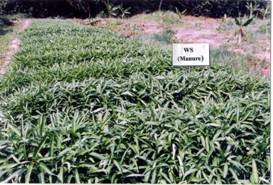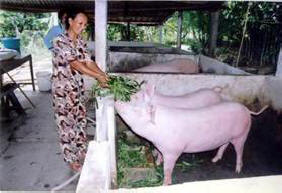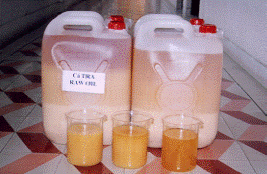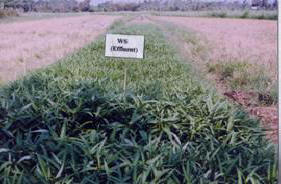On-farm evaluation of the effect of different
fertilizers on water spinach (Ipomoea aquatica) yields, and
of including water spinach and catfish oil in diets for fattening
pigs in the Mekong Delta of Vietnam
Le Thi Men, T R Preston*,
Tran Thi Thao, Bui Van Cong and Dang Ngoc Hoi
Department of
Animal Science, College of Agriculture,
Cantho University, Vietnam
ltmen@ctu.edu.vn
* UTA Foundation, TOSOLY AA#48, Socorro
Santander, Colombia
trpreston@mekarn.org
Abstract
Water spinach (WS) yield was estimated on 6 farms in the Mekong Delta. On 3 farms the WS was fertilized by pig manure compost and on 3 farms by using digester effluent. On each farm 120 m2 of land was divided into 30 plots for growing and harvesting water spinach during 2 growth cycles.
The WS fresh
biomass yield (29.8 tonnes) on pig compost was higher than for biodigester effluent (25.4 tonnes) in cycle I. However, the contents of DM and CP of WS were not different between
the two types of fertilizers. The yield
of WS and the nutritive values showed the same tendency in cycle II.
The content in dry matter basis of lysine was 0.97% vs 0.89%, threonine 1.09% vs 0.96% and methionine 0.45 % vs 0.57% for
whole plant WS cultivated by pig compost or biodigester effluent, respectively.
There was higher level in total lipid of linoleic acid (C18:2) (15.9% vs
14.1%), but lower a-linolenic acid (C18:3= 42.7% vs 43.2%) in WS cultivated by
pig compost compared with WS given biodigester fertilization.
An on-farm trial was carried out using locally available feed resources to improve the current low income of farmers. 36 Yorkshire-type pigs, comprising an equal number of castrated males and females with initial mean live weight of 54 kg were used. The trial was designed as a randomized block with six households and three dietary treatments. The basal feed was the same for the three treatments and was based on rice-by products, a protein concentrate and included: catfish oil 5% (CF5); catfish oil 5 % with water spinach 5% (CF5-WS5) and water spinach 5% (WS5).
The
daily weight gain (ADG) and feed conversion ratio (FCR) were not
affected by dietary treatment. The feed cost per kg weight gain,
and economic gross income were improved in WS5 (11%), and CF5WS5
(9%) in comparison with the CF5 diet. Overall, these results
indicate that usage of locally available feed resources as
supplements in pig diets can be recommended, especially in the
practical smallholder situation.
Key words: Biomass, catfish oil, fattening pigs,
fertilizer, local feeds, water spinach
Introduction
The Mekong delta with a large water surface area on the Tien and
Hau rivers is suitable for aquaculture, especially for the Mekong
catfish cultivation in floating houses. Large factories produce
frozen white river cobbler filet for export. Of the abundant
residues, the belly is pressed to give raw fish oil, which mainly
consists of the fatty acids C16:0 (30.1%), C18:1 (38.3%) and C18:2
(13.2%) and has an energy content of 37.6 MJ/kg (Le Thi Men et al.
2003). With 5% of catfish oil included in growing pig diets based
on rice by-product or dried cassava root waste, daily gain and feed
cost per kg gain were improved. The CP content (20%) of the pork
was not changed and the Iodine index (60) of pig fat little affected (Le Thi Men et al 2003).
Water spinach (Ipomoea aquatiac) or swamp cabbage with
short growth cycles (4 weeks each one) has crude protein (26% in DM), a balanced
array of essential amino acids (Lys
1.3%, Met 0.4%, Thr 1.1% in DM), β-carotene and ME
of 10.6 MJ/kg in dry matter basis. It has been studied for replacing a part of
protein in diets in pig feeding in the Mekong Delta (Le Thi Men and
Bui Hong Van 1994; Le Thi Men et al 1999, 2001, 2002 and
2003).
The HAT is one cultivar of water spinach this is
cultivated from seed and
gown in the soil. It has high fresh biomass yield after 3-4 weeks from sowing (Duong Hong Dat 2002), and
is rich in protein content. The
crude protein content in the leaves and stems can be as high as 32 % and
18 % in dry matter basis, respectively (Ly Thi Luyen 2003). This
vegetable can be widely used for human food, and given to rabbits,
pigs and poultry (Hongthong Phimmmasan 2003).
Animal manure is a potential replacement for chemical fertilizer
and is traditionally used by poor farmers in Vietnam. However, it
is not properly managed so that the efficiency of utilization of
the manure is not high. The introduction of low-cost biodigesters
in Southeast Asia (Bui Xuan An et al 1997) has made it possible for
small - scale farmers to convert manure into biodigester and a nutrient-rich effluent.
The hypotheses
-
Water spinach can grow well in land areas fertilized by pig manure compost or biodigester effluent and produce a high fresh yield in a recycling model for small holders in the Mekong Delta.
-
Catfish oil at 5% can be combined with fresh water spinach in diets as a nutrient and energy supplement for fattening pigs and give improved performance and benefit to farmers.
Materials and methods
Water spinach cultivation
The trial was conducted during February and May 2004 in Tan Phu
Thanh village, located around 20km from Cantho city. The economy of
the village is based mainly on agriculture, of which fruit
production ranks in first place, and rice production is the
important component of the farming systems. In addition, livestock production
includes pigs and fishery and other water resources are vital to the well-being
of the village. Based on the practical situation, 6 families raising pigs were selected and
divided into 2 groups, the first has plastic bio-digester (3 farms)
and another 3 farms do not have biodigester. Each household had
120 m2 of soil divided into 30 plots for growing
water spinach from seed. The fertilizer used was pig
manure compost or digester effluent. The fresh biomass was
harvested after 30 days by turn for two cycles.
The proportion of leaves and stems was measured in every
cycle. The whole plants or leaves and stem separated were measured
and the content of DM analysed by micro-wave radiation
(Undersander et al 1993), crude protein and amino acid concentration
(AOAC 2000). Fatty acid composition in the WS samples was
determined by the method described by Jacobs et al
(2000).
Feeding trial
The 36 Yorkshire-type pigs comprising equal numbers
of castrated males and females had 54.3 ± 6.6 kg mean initial
live weight . The experimental design included 3 dietary
treatments, replicated in 6 farms, within which pigs were
allocated to the treatments. There were 2 pigs (male and
female) in each pen, and they were given the experimental diets
three times daily. The daily allowance was restricted to about 3.5 %
of body weight. There was free access to drinking
water.
Samples of each feedstuff were taken in each farm, and the contents of DM, CP, CF, EE were analyzed according to AOAC (2000); ME was estimated according to NIAH (1995). All pigs were weighed at the initial, and final time point of the trial. Feed refusal in every pen was corrected every day.
Statistical analyses
Data were analyzed by ANOVA using the Basic statistics and
General Linear Model of Minitab Statistical Software version 13.
Sources of variation were treatments and blocks. The Tukey Test for
paired comparisons was used to separate means when the differences
were significant at the 5% level.
Results and discussion
Water spinach yield
Fresh biomass yield of water spinach was higher with use of pig compost than with biodigester effluent in both cycles I and II (Table 1).
|
Table 1. Biomass yield and crude protein content of the HAT water spinach cultivated in households of the Mekong Delta, Vietnam |
|||||
|
|
Types |
SEM |
P |
||
|
Compost |
biodigester |
||||
|
Cycle I |
Fresh biomass ( tonnes/ha) |
29.78 |
25.36 |
0.338 |
0.001 |
|
|
DM, % in fresh |
6.79 |
6.42 |
0.312 |
0.413 |
|
|
CP, % in DM |
24.47 |
22.02 |
1.252 |
0.181 |
|
Cycle II |
Fresh biomass ( tonnes/ha) |
34.88 |
30.34 |
0.396 |
0.001 |
|
|
DM, % in fresh |
5.86 |
5.71 |
0.469 |
0.824 |
|
|
CP, % in DM |
22.86 |
20.11 |
1.298 |
0.165 |
The proportion of leaves to stems was similar in both cycles and for both types of fertilizer (Table 2). .
|
Table 2. Proportion of the leaves and stems and crude protein content of the HAT water spinach cultivated in households of the Mekong Delta, Vietnam |
||||||
|
|
Kinds |
Items |
Types |
SE |
P |
|
|
Compost |
biodigester |
|||||
|
Cycle I |
Leaves |
DM, % in fresh |
6.3 |
7.3 |
0.45 |
|
|
|
|
CP, % in DM |
33.9 |
33.0 |
0.24 |
|
|
|
Stems |
DM, % in fresh |
4.1 |
4.7 |
0.197 |
|
|
|
|
CP, % in DM |
21.2 |
19.9 |
0.286 |
|
|
|
L/S |
In fresh |
44/ 56 |
42/58 |
0.61 |
|
|
|
|
DM, % in fresh |
7.2 |
7.6 |
0.569 |
0.661 |
|
Cycle II |
Leaves |
CP, % in DM |
28.5 |
25.1 |
1.126 |
0.056 |
|
|
|
DM, % in fresh |
4.4 |
4.5 |
0.425 |
0.867 |
|
|
Stems |
CP, %in DM |
15.6 |
14.0 |
0.437 |
0.028 |
|
|
L/S |
|
48/52 |
50/50 |
2.33 |
|
The content in dry matter basis of lysine was
0.97% vs 0.89%, threonine 1.09% vs 0.96% and methionine 0.45 % vs 0.57% for
whole plant WS cultivated by pig compost or biodigester effluent, respectively
(Table 3).
There was higher level in total lipid of linoleic acid (C18:2) (15.9% vs
14.1%), but lower a-linolenic acid (C18:3= 42.7% vs 43.2%) in WS cultivated by
pig compost compared with WS given biodigester fertilization.
|
Table 3. The amino acid (AA) and fatty acid (FA) compositions of the HAT water spinach cultivated in households of the Mekong Delta |
||
|
Items |
Types |
|
|
Compost |
biodigester |
|
|
DM, % |
92.25 |
92.06 |
|
CP, % |
23.68 |
21.76 |
|
AA, % DM |
|
|
|
Threonine |
1.09 |
0.96 |
|
Glutamic |
2.04 |
1.79 |
|
Glycine |
1.02 |
0.98 |
|
Valine |
1.49 |
1.45 |
|
Methionine |
0.45 |
0.57 |
|
Isoleucine |
1.51 |
1.37 |
|
Leucine |
1.66 |
1.70 |
|
Phenylalanine |
1.10 |
1.11 |
|
Histidine |
0.55 |
0.60 |
|
Lysine |
0.97 |
0.89 |
|
Arginine |
1.25 |
1.12 |
|
Fatty acids (FA), % methylester |
||
|
C14:0 (Myristic acid) |
0.30 |
0.40 |
|
C16:0 (Palmitic acid) |
23.80 |
22.40 |
|
C16:1 (Palmioleic acid) |
1.70 |
5.19 |
|
C18:0 (Stearic acid) |
5.43 |
5.61 |
|
C18:1 (Oleic acid) |
2.11 |
1.57 |
|
C18:2 (Linoleic acid) |
15.90 |
14.10 |
|
C18:3 (Linolenic acid) |
42.70 |
43.20 |
|
C20:0 (Arachidic acid) |
2.39 |
2.25 |
|
C20:1 (Eicosenoic acid) |
0 |
0.08 |
|
C22:1 (Cetoleic acid) |
2.19 |
1.83 |
|
Saturated FA, % lipid |
34.12 |
34.10 |
|
Unsaturated FA, % lipid |
65.88 |
65.90 |
Pig feeding
Crude protein and crude fibre were similar for the three dietary treatments (Table 5), but the EE and ME content of the WS5 was lower than the others with added 5% catfish oil.
|
Table 4. Analyzed chemical compositionsof the feedstuffs used in the on-farm trial |
||||||
|
|
DM, % |
In %, DM basis |
||||
|
CP |
EE |
CF |
Ash |
ME, kcal/kg |
||
|
Broken rice |
89.9±1.00 |
8.9±0.63 |
0.56±0.37 |
1.8±0.51 |
0.57±0.12 |
3,453 |
|
Rice bran |
90.2±0.53 |
10.8±4.16 |
6.8±0.37 |
11.1±2.22 |
9.2±0.72 |
2,644 |
|
Concentrate |
92.2±0.03 |
38.5±0.42 |
3.6±0.24 |
5.7±0.13 |
20.3±0.40 |
2,299 |
|
Water spinach |
6.8±0.13 |
22.4±4.87 |
5.3±0.09 |
10.5±0.17 |
14.9±0.74 |
2,500 |
|
Table 5. Ingredients, calculated chemical composition and feed costs of experimental diets for fattening pigs (in DM basis) |
|||
|
|
Diets |
||
|
CF5 |
CF5WS5 |
WS5 |
|
|
Ingredient, % |
|||
|
Broken rice |
42 |
41 |
43 |
|
Rice bran |
40 |
40 |
43 |
|
Concentrate |
11 |
8 |
8 |
|
Catfish oil1) |
5 |
5 |
0 |
|
Water spinach |
1 |
5 |
5 |
|
Premix |
1 |
1 |
1 |
|
Total |
100 |
100 |
100 |
|
Chemical composition |
|||
|
ME, MJl/kg |
13.4 |
13.4 |
12.3 |
|
CP, % |
12.6 |
12.2 |
12.7 |
|
EE, % |
7.8 |
7.8 |
3.7 |
|
CF, % |
6.1 |
6.3 |
6.5 |
|
Feed cost, VND/kg2) |
3,043 |
2,916 |
2,813 |
|
1) contained of 3.7 MJ per 100g oil |
|||
|
2)Prices per kg for broken rice: 2,600; rice bran: 2,200; protein concentrate: 7,000; catfish oil: 4,500; premix: 5,800 and water spinach: 2,632 VND in DM |
|||
Growth and feed conversion did not differ among diets (Table 6). Feed cost per kg weight gain was lower for WS (7,616 VND) than for CF5WS5 (7,884 VND) and CF5 (8,115 VND). Sale price per kg live weight of finished pigs was slightly lower (14,500 VND) for CF5 because of the fatter appearance compared with the other diets (15,000 VND). As a result, the gross income per total weight gain was higher in WS5 than in CF5WS5 and lowest in CF5 (Table 7). Thus, net economic benefit was higher in WS5 (11 %) and CF5WS5 (9%) compared with the CF5 diet.
|
Table 6. Effect of experimental diets on growth performance of pigs |
|||||
|
|
Diets |
SE |
P |
||
|
CF5 |
CF5WS5 |
WS5 |
|||
|
Daily gain, g/d |
855 |
849 |
817 |
0.022 |
0.436 |
|
Feed intake (in DM), g/d |
2,245 |
2,257 |
2,103 |
0.046 |
0.075 |
|
CP, g/d |
238 |
234 |
226 |
5.90 |
0.392 |
|
EE, |
175 |
177 |
78 |
2.80 |
0.001 |
|
FCR |
2.64 |
2.67 |
2.60 |
0.090 |
0.863 |
|
Table 7. Effect of experimental diets on economic benefit |
|||||
|
|
Diets |
SE |
P |
||
|
CF5 |
CF5WS5 |
WS5 |
|||
|
Total weight gain, kg |
82.2 |
81.1 |
78.7 |
2.62 |
0.636 |
|
Gross income1), VND |
1,192,383 |
1,216,000 |
1,180,500 |
|
|
|
Feed cost/kg gain , VND |
8,115 |
7,884 |
7,616 |
480 |
0.768 |
|
Feed expense, VND |
663,777 |
638,112 |
595,711 |
|
|
|
Gross income-Feed expense, VND |
528,606 |
577,888 |
584,789 |
|
|
|
% Relative |
100 |
109 |
111 |
|
|
|
1) The sale price of 1 kg weight gain of fattening pigs was 14,500 VND for CF5 and 15,000 VND for others |
|||||
 |
|
|
Picture 1. The 'HAT' water spinach (WS) cultivated in the
households of the Mekong Delta |
|

|
 |
| Picture 2. Collecting WS |
Picture 3. Feeding WS |
 |
 |
|
Picture 4. The raw catfish oil used in the pig
diets |
|
Conclusions
-
It is suggested that small holder farmers should cultivate vegetables as supplements for pigs, using effectively animal waste residues.
-
Diets with 5% catfish oil gave better results when combined with 5% water spinach (DM basis) than when the oil was given alone.
References
AOAC 2000 Official Methods of Analysis. American Association of Analytical Chemists. Washington, DC.,USA
Bui Xuan An, Preston T R and Dolberg F 1997 The introduction of low-cost polyethylene tube biodigesters on small scale farms in Vietnam, Livestock Research for Rural Development, 9:2 http://www.cipav.org.co/lrrd/lrrd9/2/an92.htm
Duong Hong Dat 2002 Cultivated Vegetables Manual. Hanoi Publishing House. 180 pp.
Le Thi Men and Bui Hong Van 1994 Evaluation of diets
based on simulated sugarcane juice and water spinach for breeding
sows. National Seminar Workshop Sustainable Livestock Production on
Local Feed Resources. Hanoi/Ho Chi Minh city, Vietnam.
Nov.22-27,1993
Le Thi Men, Brian Ogle and Vo Van Son 1999. Evaluation of
water spinach (Ipomoea aquatica) for Baxuyen and Large White
sows. Proceeding in National seminar-workshop. Ho Chi Minh City,
VN. January 18-20 of 2000
http://www.mekarn.org/sarpro/lemen.htm
Le Thi Men, Huynh Huu Chi, Ngo Vi Nghia, Nguyen Thi Kim Khang, Ogle B and Preston T R 2003 Utilization of catfish oil in diets based on dried cassava root waste for crossbred fattening pigs in the Mekong delta of Vietnam Livestock Research for Rural Development (15) 4 Retrieved May 3, 2004, from http://www.cipav.org.co/lrrd/lrrd15/4/men154.htm
Le Thi Men, M. Yamazaki and R. Takada 2002
Determination of Amino Acids in Animal Feed Stuffs with High Performance Liquid Chromatography
(unpublished)
Ly Thi Luyen 2003 Effect of the urea level on biomass
production of water spinach (Ipomoea aquatica) grown in
soil and water. Retrieved, from MEKARN Mini-projects http://www.mekarn.org/MSc
2003-05/miniprojects.htm
Hongthong Phimmmasan 2003 Water spinach (Ipomoea
aquatica) as a low-cost feed resources for growing rabbits.
Retrieved, from MEKARN Mini-projects. http://www.mekarn.org/MSc
2003-05/miniprojects.htm
Undersander D, Merten D R and Thiex N 1993. Forage
analyses procedures. National Forage Testing Association. New York.
